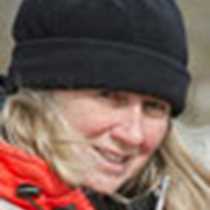Padloping Island, Nunavut
We follow the fringe of summertime, southward bound. Days shorten rapidly. Curtains of color dance in the night sky as if to entice summer to stay. But brilliant sunshine still comes early creeping in the cracks around porthole covers or window shades.
Morning arrived with promises of perfect weather. Blue skies were streaked with barely a brushstroke of filmy white clouds and the sea had that classic crumpled satin surface, a mosaic of navy and gray. Cape Searle’s blocky countenance rose abruptly from the sea. Fulmars, our constant companions these past weeks, multiplied their ranks and anticipations arose of viewing their nesting sites. But from the Arctic Circle, where legend says fog dwells, stealthy fingers of whiteness advanced wrapping tendrils about the cliffs and soon about us as well. Sun and fog, then fog and sun blended to form our day.
Padloping Island was as strange a juxtaposition as was the fog and sun. A polar bear paced protecting the eastern shore. Was it the inuksuks that kept him there away from our landing site or just lethargy produced by a paucity of food in summer time? A skull of his kind lay at the feet of an inuksuk at the shore, the backbone and pelvis near another on a hill. Here was a symbol, a remnant of ancient traditions, a man of stone with head and arms but why here? This was no cairn to guide a hunter home or to mark a favored fishing spot. Was it here to reassure that the future would be brighter? What has man done to this wilderness? Long ago when conflicts raged upon a distant shore Quonset huts sprouted from this soil. Machinery roared and trucks bumped across the tundra. They sit there now, crumbling and rusting. Decaying remnants of life litter the land. Upon their faces are stamped US Army. The Canadian Navy did no better. No one cleaned their rooms.
Steps away, the hummocked ground drew us further and further. Blueberry bushes blushed with reddening leaves and wintergreen rosettes turned magenta. Lichens painted tops of rocks in black and grey and sage while mosses cascaded alongside miniature rivulets. The haunting call of a loon echoed from cliff sides grooved and plucked by glaciers. A rocky moraine corralled a freshwater lake perched above the sea. It was easy to turn our backs to the debris, to savor the smells and colors of the tundra. But looking away is not the solution to man’s pollution.
We follow the fringe of summertime, southward bound. Days shorten rapidly. Curtains of color dance in the night sky as if to entice summer to stay. But brilliant sunshine still comes early creeping in the cracks around porthole covers or window shades.
Morning arrived with promises of perfect weather. Blue skies were streaked with barely a brushstroke of filmy white clouds and the sea had that classic crumpled satin surface, a mosaic of navy and gray. Cape Searle’s blocky countenance rose abruptly from the sea. Fulmars, our constant companions these past weeks, multiplied their ranks and anticipations arose of viewing their nesting sites. But from the Arctic Circle, where legend says fog dwells, stealthy fingers of whiteness advanced wrapping tendrils about the cliffs and soon about us as well. Sun and fog, then fog and sun blended to form our day.
Padloping Island was as strange a juxtaposition as was the fog and sun. A polar bear paced protecting the eastern shore. Was it the inuksuks that kept him there away from our landing site or just lethargy produced by a paucity of food in summer time? A skull of his kind lay at the feet of an inuksuk at the shore, the backbone and pelvis near another on a hill. Here was a symbol, a remnant of ancient traditions, a man of stone with head and arms but why here? This was no cairn to guide a hunter home or to mark a favored fishing spot. Was it here to reassure that the future would be brighter? What has man done to this wilderness? Long ago when conflicts raged upon a distant shore Quonset huts sprouted from this soil. Machinery roared and trucks bumped across the tundra. They sit there now, crumbling and rusting. Decaying remnants of life litter the land. Upon their faces are stamped US Army. The Canadian Navy did no better. No one cleaned their rooms.
Steps away, the hummocked ground drew us further and further. Blueberry bushes blushed with reddening leaves and wintergreen rosettes turned magenta. Lichens painted tops of rocks in black and grey and sage while mosses cascaded alongside miniature rivulets. The haunting call of a loon echoed from cliff sides grooved and plucked by glaciers. A rocky moraine corralled a freshwater lake perched above the sea. It was easy to turn our backs to the debris, to savor the smells and colors of the tundra. But looking away is not the solution to man’s pollution.




